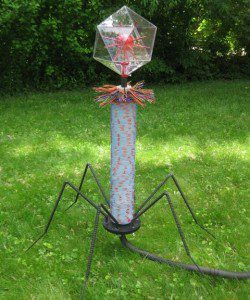

Our first example is a 68-year old diabetic who developed necrotizing pancreatitis and infection with multi-drug resistant Acinetobacter baumanii. Nine different bacteriophages were identified that could lyse A. baumanii isolated from the patient. The phages were administered intravenously and intracavitary beginning at day 109 after infection. On day 115 the A. baumanii isolate was found to be susceptible to minocycline and this antibiotic was added to his therapy. Subsequently the bacterial isolates were found to be resistant to phage therapy, and new phages were identified that could infect these bacteria. These treatments reversed the patient€™s decline and returned him to health.
This remarkable saga was recounted with members of two laboratories who worked with the phages used in this case on TWiV #501, Texas road phage. The patient€™s wife recently published her account of this story in A Perfect Predator.
Our second case is about a 76 year old patient who was given a Dacron graft to repair an aortic aneurysm. The graft became infected with Pseudomonas aeruginosa and over the next several years the patient returned to hospital for multiple attempts to eliminate the infection. Surgery was deemed too risky for the patient, and rather than submit to a lifetime of antimicrobial treatment, he agreed to undergo experimental phage therapy. The virus used, OMKO1, had been previously shown to infect P. aeruginosa by attaching to an outer membrane protein that is part of a pump that removes antibiotics from the cell. If this bacterial protein changed to prevent phage attachment, then the pump would be inactivated, blocking antibiotic resistance. The patient was treated with a single dose of 108 phages plus antibiotics applied near the aortic graft. After this single dose the patient recovered completely. Sadly, he died of a heart attack the day his case history was published.
We spoke with Paul Turner, one of the authors of this study, on episode #44 of the science podcast This Week in Evolution.
More recently a 15 year old patient with cystic fibrosis and multiple comorbidities developed disseminated infection with Mycobacterium abcessus after lung transplant and immunosuppression. Antimicrobial treatment was given but did not prevent development of multiple skin lesions and breakdown of the surgical wound. From a collection of over 10,000 phages identified by the SEA-PHAGES program, three were identified that infected an isolate of M. abcessus from the patient. One of the phages killed the bacteria efficiently; a second did not and was therefore genetically modified to inactivate the repressor protein. A third phage did not efficiently infect the bacterial isolate, so host range mutants were identified with improved infection properties. The patient was given this three phage cocktail every 12 hours for 32 weeks. During this time the patient showed substantial clinical improvement, marking the first therapeutic use of phages for mycobacterial infection and the first use of engineered phages.
These three isolated reports do not constitute the clinical trials required for licensing of phage therapy. However they do show how molecular biology has enabled us to modify phages and develop new approaches for treating bacterial infections.
A recent excellent review of the field is Phage Therapy: A Renewed Approach to Combat Antibiotic-Resistant Bacteria (unfortunately paywalled).

Pingback: Phage therapy gains momentum – Virology Hub
Working on the translation side, this is going to require one or more of:
– New legislation creating a class of phage drugs for FDA that allows much easier approval based on class. Because it is just too costly to run classical clinical trials for each different phage.
– Large grant support for phage treatments to make them available for drug resistant cases.
Phages, unless engineered, have no patent protections and pharma and venture capital find this anathema. And it’s better to do directed evolution in most cases.
Phages can be preserved, but they require special handling.
Phages can’t be distributed like antibiotics. In some ways this is good. Agriculture won’t destroy their effectiveness. But it also means that getting them to people requires they be distributed like live vaccines from pharmacies. That’s inherently more expensive.
Don’t get me wrong. I like phages. I would like to see them available, and become another tool for physicians to use. The pharma-industrial system though, is not conducive to it.
Many people already have antibodies to many medically potential phages. They are ubiquitous in the gut.